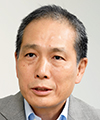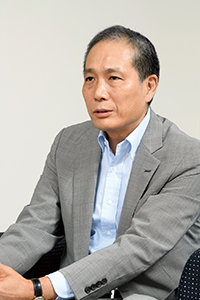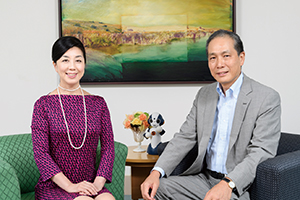 |
|||
|
|
|||
|
View from the Top Vol. 14, No. 11, pp. 1–5, Nov. 2016. https://doi.org/10.53829/ntr201611tp1  Establishing a Global and Local Brand of NTT DATA with an Eye to Our Clients’ FutureOverviewEiji Ueki, NTT DATA Executive Vice President, believes in the importance of strengthening global brand power by developing trustworthy relationships with clients and providing new value with an eye to their future. We asked Mr. Ueki how NTT DATA plans to face the challenges ahead. Keywords: management plan, global brand, client relations Innovative production technologies and advanced technologies as keys to the future—Mr. Ueki, as Executive Vice President in charge of the financial segment and technology strategies, please tell us about the current state of business and the areas of focus of NTT DATA. In the Medium-Term Management Plan running from fiscal year (FY) 2012 to FY2015 (the period from April 1, 2012 to March 31, 2016), we set specific targets of becoming a global top 5 enterprise (net sales of 1.5 trillion yen) and achieving earnings per share (EPS) of 200 yen. To this end, we defined three areas of action: expansion of new fields and reinforcement of product competitiveness; expansion, enhancement, and reinforcement of global business; and pursuit of overall optimization. In domestic operations, our remarketing initiatives and control of unprofitable projects put us on an upward trend from FY2013 in both sales and profit, and in our overseas operations, steadily increasing sales enabled us to achieve our net sales and EPS targets in FY2015. The business of NTT DATA has traditionally been in the public and financial segments, which have been the company’s dominant fields since the Nippon Telegraph and Telephone Public Corporation era. Against this background, we have been accelerating our activities in the corporate domain with an eye to expanding business even further. Moreover, to establish good relations with Japanese enterprises that are aggressively expanding their business globally, we ourselves have been actively pursuing globalization through merger and acquisition (M&A) activities over the last ten years. Here, we have been targeting overseas companies that have a close affinity with the business of NTT DATA or that have know-how related to enterprise resource planning (ERP) packages. As a result, our global business volume has been increasing year-to-year. However, in comparison with its name recognition in Japan, NTT DATA has yet to establish itself as a globally recognized brand. For this reason, the new Medium-Term Management Plan calls for business growth and greater local presence in every region of the world and establishment of a truly global brand toward the Global 2nd Stage, as a basic policy called NTT DATA: ASCEND (Rise and grow as a global brand). Two major pillars of the new Medium-Term Management Plan are creating value through a “Game-Changing Approach” and “Breakthrough Technology.” The latter seeks to enhance technological competence—a major element of NTT DATA’s business—through innovation in production technology and application of cutting-edge technologies to provide clients with high-value systems. As for innovation in production technology, we are promoting the automation of software development, the accumulation and expansion of legacy modernization technologies for smooth upgrading of large-scale legacy systems, and an agile development approach. In particular, we have been engaged in the automation of software development for some time, but further efforts will be made. This is because automation enables us to focus as never before on what kind of system should be created to grow the client’s business and provide the client with value. Consequently, the automation of software development helps us to provide our clients with high-value systems. Regarding the application of cutting-edge technologies, we are constantly keeping an eye on new technology trends and researching and developing new technologies in up-and-coming fields such as artificial intelligence (AI), Internet of Things (IoT), and robotics in collaboration with NTT laboratories. Plus, in fields that are difficult to go into alone or that demand rapid development, we are pursuing open innovation through efforts such as forming tie-ups with start-up companies. In this way, given that information technology (IT) is continuously evolving, we seek early adoption of the latest developments to provide clients with high-added-value systems.
—How are you working, in particular, to increase brand power? From the viewpoint of technology development, I believe that using new technologies in actual business and establishing a proven track record in this regard can help increase brand power. For example, there’s Sota®*, a communication robot that performs advanced intelligent processing using a cloud robotics platform. A Sota robot can be positioned at a bank’s reception desk to provide guidance to visitors and direct them to the teller counter. The finance industry, which is generally thought to be somewhat conservative, is now expressing interest in new technologies such as financial technology (FinTech) and robots. Within Japan, I would like to enhance the NTT DATA brand by providing solutions to the public, finance, and enterprise segments. In the public segment, I would like to provide solutions related to the My Number (social security and tax number) system. In the finance segment, I want to provide FinTech-related solutions and core systems as well as solutions that help improve the client’s top line. In the enterprise segment, I would like to build up our track record in providing omni-channel retailing- and IoT-related solutions. In the overseas market, where the NTT DATA name was once unknown for the most part, we have obtained a certain amount of name recognition through corporate sponsorship of the British Open in golf and IndyCar Series racing in the United States. Nevertheless, we still have to improve our brand power by promoting our successes in the actual business domain. In this sense, let me give you two examples of business achievements that have propelled us forward. The first is our digital archive project with the Vatican Apostolic Library, which I believe will have great appeal to the many followers of the Roman Catholic religion throughout the world and the many people that visit the Vatican every year. Furthermore, as an additional benefit, being involved in such a magnificent project has had a very positive effect on NTT DATA employees. The second example is our business with globally expanding automobile manufacturers. Thanks to our M&A of Cirquent, an information systems subsidiary of BMW in Germany, we have received orders from BMW and also from Daimler and Volkswagen, thereby expanding our global support business on a scale of 10 billion yen annually in sales. I would like to strengthen the NTT DATA brand by improving our track record of such successes one project at a time.
Building trustworthy relationships with our clients at every level—What is essential to developing business relationships with clients? To begin with, we must keep in mind that the client comes first. One positive quality of NTT DATA that has been true from the start is the building of long-term relationships. In other words, NTT DATA places importance not on the short term but on loyalty based on trustworthy relationships that may span five to ten years. While the world may change because of IT, relationships with business-to-business (BtoB) clients do not change greatly. We are expected to contribute to the growth of our clients’ businesses as part of such a trustworthy relationship. At the same time, it is essential that we provide our clients with know-how and solutions that we possess whenever such changes in technology occur. NTT DATA annually updates its NTT DATA Technology Foresight report that describes technology trends and future uses of IT for the benefit of its clients. While discussing what that outlook means for our clients’ businesses and proposing new solutions, we develop forward-looking business. Long-term relationships are necessary not just at the top executive level but at every level of a company including management, system development, and on-site operation. For example, in the construction of an integrated services center for banks, system development should only start after coordinating the interests of the stakeholders and creating a win-win relationship among all clients in the planning stage. In addition, if certain conditions should arise that can affect the system construction schedule, an effort must be made to revise the development scheme and minimize the impact while asking the clients to make adjustments to their requirements if necessary. Furthermore, the occurrence of a problem in a bank’s core system—something that should never be allowed to happen—can have a huge impact not only on the client, that is, the bank, but also on ordinary people who use that bank. At such a time, it is essential that the client’s understanding and cooperation be obtained in hammering out a solution to minimize the impact as much as possible. A trustworthy relationship with the client is vital at practically all stages of system provision, from system planning and development to system operation.
—What are you doing to help employees broaden their perspective? Our business is project based, so employees cannot help but be concerned only about their current project. Similarly, executive managers supervise business efforts on a department-by-department basis such as whether they concern public services or financial services, and as a result, they tend to fall into a vertical and compartmentalized frame of mind. For this reason, we have set up a system called “executive caravan” in which executive managers make on-site visits to other departments. I have heard from the person in charge of this system that managers encounter all kinds of interesting challenges in these visits and always discover something new. In addition, NTT DATA opened the “From the Toyosu Port” Open Innovation Forum three years ago. The idea here was to provide a forum for NTT DATA, NTT DATA clients, and start-ups with groundbreaking technologies to come together and combine novel ideas and technologies, all with the aim of producing innovative services quickly. This forum has also come to be used as a place where NTT DATA employees can step outside the departments they belong to and propose new business ventures in a cross-disciplinary, autonomous manner. Moreover, in cooperation with overseas start-ups and the embassies of their countries, it has become a very energetic site fostering a lively exchange of ideas based on the interesting technologies of those start-ups and themes proposed by NTT DATA clients as well. However, these activities are not only meant to produce new ideas. For ideas that are original and interesting but that lack a means of realization, the forum is starting to produce results by applying such ideas to actual services. For example, linking Japan’s ANSER Internet banking service with a household budget ledger app makes for a service that enables the user to access information from multiple financial institutions without having to worry about identifications and passwords. —What is the role of NTT DATA within the NTT Group? In 1988, NTT DATA was spun off from NTT as an independent company, but at that time, the relationship between telecommunications operators and system integrators was not that deep. In addition, the majority of current NTT DATA employees joined the company after its founding, which meant that they had only slight exposure to the corporate culture at Nippon Telegraph and Telephone Public Corporation and NTT. As a result, NTT DATA seemed to have a somewhat separate existence within the NTT Group. However, the recent spread of digital technologies such as IoT and cloud computing has made it important that we coordinate with the NTT Group to provide our clients with full-support services. In this regard, I believe that we are already producing results. Particularly, in our overseas operations, where the brand power of NTT DATA and even that of NTT is weak, such coordination is becoming increasingly important to establish a successful track record on a global basis. In research and development too, the direction of research since the completion of the DIPS mainframe development has been somewhat different from the business of NTT DATA. This created the impression of two companies that are distant from each other, but in these last few years, we have become much closer. The robot dialogue control and AI applications that I mentioned earlier are good examples of this trend. Based on the basic technologies coming out of NTT laboratories, we are becoming increasingly successful in arranging and providing NTT technologies to our clients.
—In light of this situation, what would you like to say to NTT DATA researchers? The IT domain is extremely broad and I’m sure researchers too are often at a loss as to what should be researched and developed. So I would ask researchers in their daily work to constantly think about what areas of IT might be important for our clients instead of being obsessed with immediate matters. If a researcher is not contemplating what clients want and what their latent needs might be, and how technology can be used to meet those needs, it is easy to fall into a state of complacency. Those of us in the NTT DATA business division can provide valuable information that we obtain from our clients, so I would like to produce good results by establishing clear channels of communication between us and NTT DATA’s researchers to make the world a better place. —Mr. Ueki, please leave us with a message for all NTT DATA employees too. To move business forward, it is important that we exchange all kinds of ideas and that we share our problems and search for solutions together. Instead of worrying only about one’s own project, working in a synergetic manner across multiple projects can create new business opportunities or provide clients with new value. To this end, I would like to ask all employees to make an effort to widen their perspective. Also, for those employees who are active overseas, I emphasize that relationships with clients in every region of the world are of prime importance. So to begin with, please work diligently to build up business in your regions. At the same time, please adopt a mindset that sees solutions as something that can be cultivated by applying the synergy of the NTT DATA Group, and carry out your work while looking at things from the viewpoint of the entire group. Interviewee profileCareer highlightsEiji Ueki entered Nippon Telegraph and Telephone Public Corporation (now NTT) in 1981. Following the spinoff of the NTT Data Communications division as NTT DATA Corporation in 1988, he served as Senior Vice President, Head of the Second Financial Sector from 2009, Director and Senior Vice President, Head of Group Strategy Headquarters from 2013, and Director and Executive Vice President from 2015. He took up his current post as Representative Director and Executive Vice President in June 2016. |
|||



